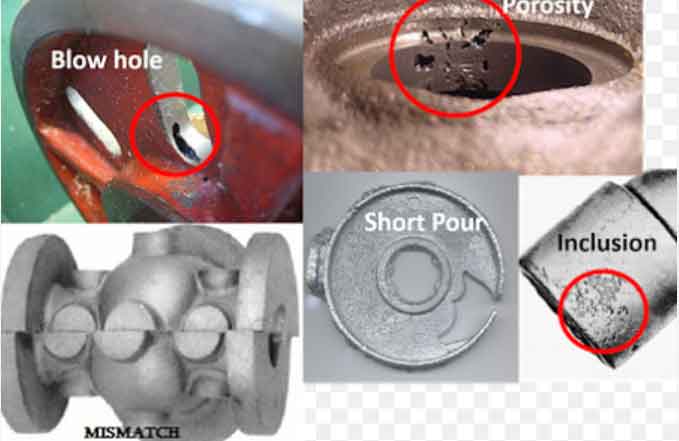Casting defects can significantly impact the quality and reliability of metal components. To produce flawless castings, it is crucial to understand the causes behind these defects and implement effective solutions. This article delves into the common causes of casting defects and presents strategies to address them, unraveling the mystery behind these issues.

1.Porosity:
Porosity occurs when voids or gas pockets form within the cast metal. It can be attributed to factors such as trapped gases, improper venting, or inadequate feeding. Solutions include:
- Ensuring proper degassing of the molten metal to eliminate dissolved gases.
- Implementing effective gating and riser systems to allow gases to escape during solidification.
- Utilizing mold coatings or additives to minimize gas absorption by the mold.
2.Shrinkage:
Shrinkage defects arise when the metal contracts unevenly during solidification, leading to voids or shrinkage cavities. Causes include inadequate feeding, improper riser design, or incorrect alloy selection. Preventive measures include:
- Designing the casting with proper riser size and location to provide additional molten metal for feeding.
- Controlling solidification rates through optimized cooling techniques, such as the use of chills or controlled cooling channels.
- Selecting alloys with minimized shrinkage characteristics or using compensatory materials to counteract shrinkage.
3.Inclusions:
Inclusions refer to foreign materials trapped within the casting, such as oxides, refractory particles, or sand. They can result from improper mold preparation, contaminated raw materials, or inadequate pouring practices. Solutions include:
- Using high-quality refractory materials for molds and cores to reduce the risk of sand-related inclusions.
- Implementing effective filtering systems to remove impurities from the molten metal.
- Regularly maintaining and cleaning the furnace and crucible to minimize oxide formation.
4.Cold Shuts:
Cold shuts occur when two or more metal streams fail to fuse completely, resulting in weak joints. Causes include inadequate pouring temperature, improper gating, or insufficient mold filling. Preventive measures include:
- Ensuring proper pouring temperature to promote complete fusion of molten metal streams.
- Optimizing gating and runner designs to facilitate uniform filling and minimize fragmentation of metal streams.
- Modifying the mold cavity design to enhance metal flow and reduce the possibility of incomplete fusion.
5.Misruns and Laminations:
Misruns occur when the molten metal fails to completely fill the mold cavity, while laminations refer to layered defects within the casting. Causes include improper gating, inadequate pouring time, or low metal fluidity. Solutions include:
- Optimizing gating and runner systems to achieve smooth and complete mold filling.
- Controlling pouring temperature, speed, and metal fluidity to ensure proper mold cavity filling.
- Utilizing appropriate pouring techniques, such as bottom pouring or tilt pouring, for complex castings.
6.Warpage and Distortion:
Warpage and distortion defects result from non-uniform cooling or inadequate dimensional control during solidification. Causes include improper mold design, residual stresses, or inadequate cooling systems. Preventive measures include:
- Employing optimized cooling and solidification control techniques, such as the use of cooling channels or controlled cooling rates.
- Selecting casting alloys with lower thermal expansion coefficients to minimize distortion.
- Implementing proper heat treatment or stress-relieving processes to reduce residual stresses.
Understanding the causes and solutions of casting defects is vital for producing high-quality castings. By addressing factors like porosity, shrinkage, inclusions, cold shuts, misruns, warpage, and distortion, manufacturers can minimize defects and achieve superior castings. Continuous process analysis, comprehensive quality control measures, and collaboration between casting experts and foundry personnel are crucial to unravel the mystery of casting defects and ensure the production of flawless metal components.
